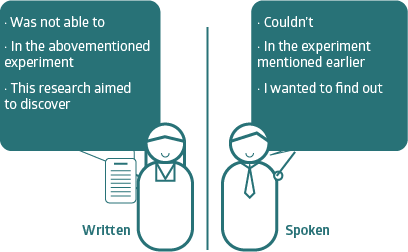When Writing For A General Audience, Students Should Choose Words That Are
Giving effective presentations: 5 ways to present your points with power, not just PowerPoint

The prospect of giving a presentation fills some people with dread, while others relish the experience. However you feel, presenting your work to an audience is a vital part of professional life for researchers and academics. Presentations are a great way to speak directly to people who are interested in your field of study, to gather ideas to push your projects forward, and to make valuable personal connections.
In this article, I'll give some tips to help you prepare an effective presentation and capitalize on the opportunities that giving presentations provides.
Also, you might want to try our e-learning module and quiz on how to change the style of phrases we commonly write in research papers into those we would naturally say aloud in presentations. See Tip 4 below for details.
Tip 1: Know your audience
The first and most important rule of presenting your work is to know your audience members. If you can put yourself in their shoes and understand what they need, you'll be well on your way to a successful presentation. Keep the audience in mind throughout the preparation of your presentation.
By identifying the level of your audience and your shared knowledge, you can provide an appropriate amount of detail when explaining your work. For example, you can decide whether particular technical terms and jargon are appropriate to use and how much explanation is needed for the audience to understand your research.
What is your audience's level of expertise and what knowledge do you have in common?
You can also decide how to handle acronyms and abbreviations. For example, NMR, HMQC, and NOESY might be fine to use without definition for a room full of organic chemists, but you might want to explain these terms to other types of chemists or avoid this level of detail altogether for a general audience.
It can be difficult to gauge the right level of detail to provide in your presentation, especially after you have spent years immersed in your specific field of study. If you will be giving a talk to a general audience, try practicing your presentation with a friend or colleague from a different field of study. You might find that something that seems obvious to you needs additional explanation.
Get featured articles and other author resources sent to you in English, Japanese, or both languages via our monthly newsletter.
We will never spam you or sell your information and you can unsubscribe any time | Click to view privacy policy
Tip 2: Create a clear, logical structure
Next, you'll need to think about creating a clear, logical structure that will help your audience understand your work. You're telling a story, so give it a beginning, middle, and end.
To start, it can be helpful to provide a brief overview of your presentation, which will help your audience follow the structure of your presentation. Then, in your introduction, get everyone "on the same page" (i.e., provide them a shared reference point) by giving them a concise background to your work. Don't swamp them with detail, but make sure they have enough information to understand both what your research is about and why it is important (e.g., how it aims to fill a gap in the research or answer a particular problem in the field). By making the foundation of your research clear in the introduction, your audience should be better able to follow the details of your research and your subsequent arguments about its implications.
In the main part of the presentation, talk about your work: what you did, why you did it, and what your main findings were. This is like the Methods and Results sections of a manuscript. Keep a clear focus on what is important and interesting to your audience. Don't fall into the trap of feeling that you have to present every single thing that you did.
Take-home message:
If my audience remembers one thing from my talk, what do I want it to be?
Finally, summarize your main results and discuss their meaning. This is your opportunity to give the audience a strong take-home message and leave a lasting impression. When crafting your take-home message, ask yourself this: If my audience remembers one thing from my talk, what do I want it to be?
When you are considering how long each section should be, it is helpful to remember that the attention of the audience will usually wane after 15–20 minutes, so for longer talks, it's a good idea to keep each segment of your presentation to within this amount of time. Switching to a new section or topic can re-engage people's interest and keep their attention focused.
3. Write for your specific readers: consider shared knowledge
Visual materials, probably in the form of PowerPoint slides, are likely to be a vital part of your presentation. It is crucial to treat the slides as visual support for your audience, rather than as a set of notes for you.
A good slide might have around three clear bullet points on it, written in note form. If you are less confident speaking in English, you can use fuller sentences, but do not write your script out in full on the slide.
As a general rule, avoid reading from your slides; you want the audience to listen to you instead of reading ahead. Also, remember that intonation can be 'flattened' by reading, and you don't want to put the audience to sleep. However, if you need to rely on some written text to explain some difficult points and calm your nerves, make sure you pause and look at the audience between these points; then go back to talking and not reading the next slide.

Ideally, the slides should focus on relevant visual material, such as diagrams, microscope images, or chemical structures. A good diagram can be far easier for people to understand than words alone. Make sure that you point to the slides as you talk. This will help guide the audience's attention to the correct part of the slide, and can keep them engaged with what you are explaining.
Make sure your visual materials are easy to read. Use dark lettering on a pale background for maximum visibility; pale lettering on a dark background can be difficult to read. Choose a standard clear font, like Arial or Times New Roman, and make sure that the size is large enough to be seen from the back of the room. Lay out the slides so that the elements are properly spaced. It is better to split a slide into two or three separate slides instead of overfilling one slide. Although your time is limited, your number of slides is not!
Remember that you are not writing a manuscript, so you don't have to use complete sentences. On your slides, verbs (especially "be" verbs) can be omitted. An example is shown in the figure.
Tip 4: Talk in "spoken English" style, not in "written English" style
The style of spoken English is quite different from that of written English. If you are preparing your script from text in a research paper, you will need to change the style of the written phrases into that of spoken phrases.
The written English we read in research papers often has a very formal style, using complex vocabulary and grammatical structures. This level of complexity is possible because readers can take their time reading papers to understand the content fully and can look up unfamiliar words or grammatical phrases as needed. This is not possible when listening to spoken English, when the audience hears your point once and fleetingly (this is why brief text and images on your slides can help convey your message fully).

You can learn about the characteristics of written English versus those of spoken language in a free e-learning module and quiz we have prepared.
Also, check back for a later edition of our newsletter to find out how best to deliver your spoken presentation.
Tip 5: Practice your presentation and practice again!
Public speaking is the part of presentations that most people dread. Although it might not be possible to get over your nerves completely, good preparation and practice will give you confidence. Most confident speakers do lots of preparation and use notes well.
After you've written your script, practice and learn is—not so that you learn to say it by rote, but so that it will become easier to remember the important points to say, the links between the points (to maintain the flow of your 'story'), and the words and phrases that express your points clearly.
One way that we at ThinkSCIENCE can help you with this is through our audio recording service, in which a native speaker records your script at your chosen speed (native speed, slightly slower, or considerably slower). You can then use the recording to practice pronunciation, intonation, and pacing.
Again, if possible, try to avoid reading directly from your slides or script. Once you know your script, you can make a simple set of notes to jog your memory. If you are speaking instead of just reading, you can better engage with your audience and capture their attention.
Leave yourself adequate time to practice your presentation with your notes and slides. Check your timing, remembering that you might speak a little faster if you are nervous, and that you will need to account for changing slides and pointing at visual material.
As you rehearse, you will probably notice some words that are awkward to say, particularly if English is not your first language. Check pronunciation with a reliable source, such as www.howjsay.com, an online dictionary, or a native speaker, and then practice to avoid stumbling and putting yourself off during the presentation.
Practice can help you feel more comfortable with your material and more confident to present it to others.
Concluding remarks
Remember the importance of knowing your audience, giving yourself time to prepare thoroughly, and structuring your talk appropriately. And, don't panic!
At ThinkSCIENCE, we have years of experience helping people prepare effective research and conference presentations. From comprehensive editing and translation of your slides and scripts to our audio recording service, we can help you get ready for your presentation. We also offer one-on-one private presentation coaching sessions to help you make the most of your opportunities to present, and provide semester courses to young researchers.
I hope these tips will help you to prepare your English presentations with confidence.

Stay up to date
Our monthly newsletter offers valuable tips on writing and presenting your research most effectively, as well as advice on avoiding or resolving common problems that authors face.

Do you have a question about academic writing or publishing?
Our online Q&A support service offers researchers, physicians, and academics quick and easy online access to specialist editors.
Ask questions and receive the answers in English or Japanese.
When Writing For A General Audience, Students Should Choose Words That Are
Source: https://thinkscience.co.jp/en/articles/effective-presentations
Posted by: robinsongropen.blogspot.com

0 Response to "When Writing For A General Audience, Students Should Choose Words That Are"
Post a Comment